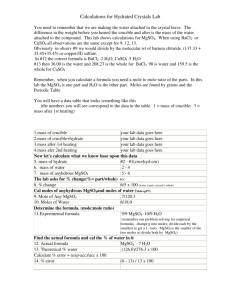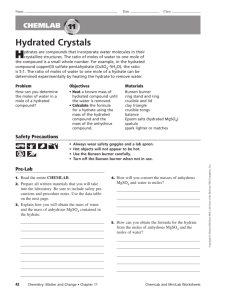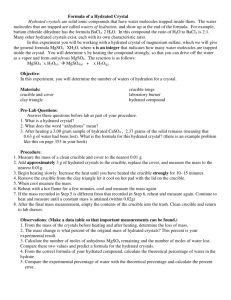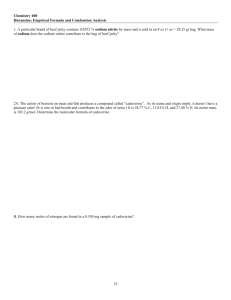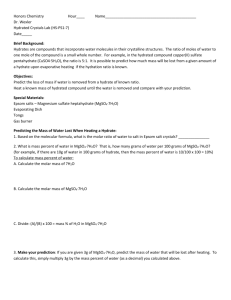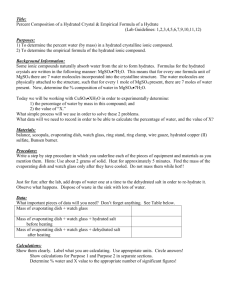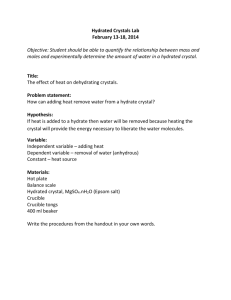Chem 1 Unit 9 Lab Report
advertisement
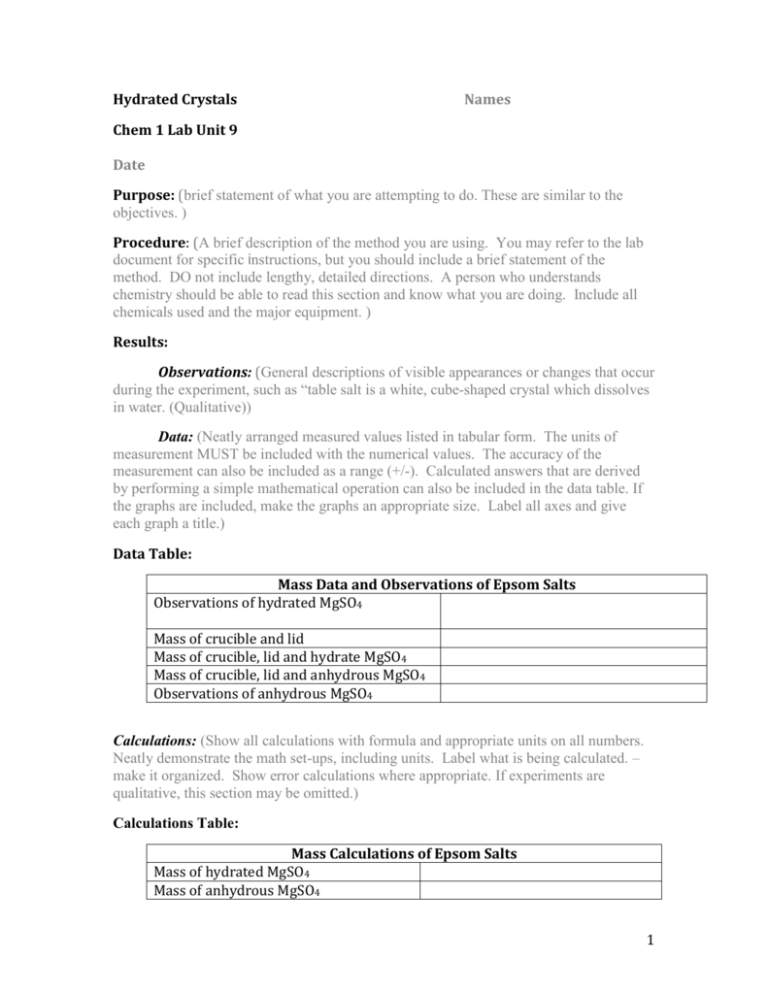
Hydrated Crystals Names Chem 1 Lab Unit 9 Date Purpose: (brief statement of what you are attempting to do. These are similar to the objectives. ) Procedure: (A brief description of the method you are using. You may refer to the lab document for specific instructions, but you should include a brief statement of the method. DO not include lengthy, detailed directions. A person who understands chemistry should be able to read this section and know what you are doing. Include all chemicals used and the major equipment. ) Results: Observations: (General descriptions of visible appearances or changes that occur during the experiment, such as “table salt is a white, cube-shaped crystal which dissolves in water. (Qualitative)) Data: (Neatly arranged measured values listed in tabular form. The units of measurement MUST be included with the numerical values. The accuracy of the measurement can also be included as a range (+/-). Calculated answers that are derived by performing a simple mathematical operation can also be included in the data table. If the graphs are included, make the graphs an appropriate size. Label all axes and give each graph a title.) Data Table: Mass Data and Observations of Epsom Salts Observations of hydrated MgSO4 Mass of crucible and lid Mass of crucible, lid and hydrate MgSO4 Mass of crucible, lid and anhydrous MgSO4 Observations of anhydrous MgSO4 Calculations: (Show all calculations with formula and appropriate units on all numbers. Neatly demonstrate the math set-ups, including units. Label what is being calculated. – make it organized. Show error calculations where appropriate. If experiments are qualitative, this section may be omitted.) Calculations Table: Mass Calculations of Epsom Salts Mass of hydrated MgSO4 Mass of anhydrous MgSO4 1 Mass of water in hydrated MgSO4 Moles of anhydrous MgSO4 Moles of water in hydrated MgSO4 Ratio of anhydrous moles to moles of water Conclusion: (Make a simple statement concerning what you can conclude form the experiment. Refer back to the purpose of the lab to write this section. (i.e. How was the purpose of the experiment fulfilled?)) Discussion of Theory: (In this section you should include such information as: What theory was demonstrated in this experiment (Include concepts used in the experiment)? What do the calculations show? Why does (or doesn’t) the experiment work? This section shows me that you understand the concepts used in the lab. Be detailed and ask if you need help! ) Experimental Sources of Error: (What are some specific sources of error, and how do they influence the data? Do they make the values obtained larger or smaller than they should be? Which measurement was the least precise? Instrumental error and human error exist in all experiments, and should not be mentioned as a source of error unless they caused a significant fault. Significant digits and mistakes in calculations are NOT a valid source of error. In writing this section it is sometimes helpful to ask yourself what you would do differently if you were to repeat the experiment and wanted to obtain better precision. If you can calculate percent error, do so and include in this section. ) Post Lab Questions: (Answer any questions included in the lab. Answer in such a way that the meaning of the question is obvious in your answer. ) 1. Using your experimental data, calculate the formula for hydrated MgSO4. Please see section 9.4 example problems if you need help. This calculation can be turned in on a separate piece of paper, if preferred. 2. How do appearances of the hydrated and anhydrous MgSO4 crystals compare? How are they different? 3. If the hydrate’s formula is MgSO47H2O, what is the percent error for hydrated MgSO4? What are the possible sources of error? What procedural changes could you make to reduce the error? 4. Predict the result of leaving the anhydrous crystals uncovered overnight. What would be different? 2

